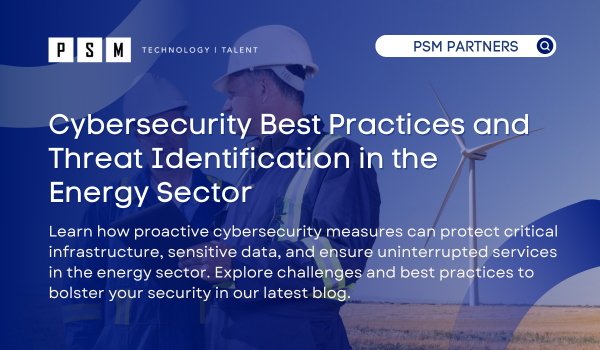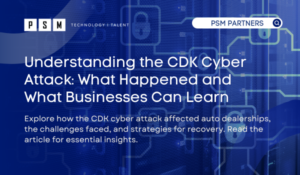Table of Contents
ToggleIn recent years, the Energy Sector has been a primary focus for cyber attackers. A survey revealed that 46% of energy attacks specifically targeted organizations in North America. This statistic highlights the vulnerability and significant targeting of energy companies in North America by cyber attackers, who engage in various malicious acts such as data manipulation, stealing or disrupting data, exploiting vulnerabilities to steal information and money, and disrupting essential services. By taking a proactive and integrated approach to cybersecurity, energy companies can better safeguard their critical infrastructure, protect sensitive data, and ensure the uninterrupted delivery of energy services to consumers. In this blog, we’ll delve into the top cyber threats facing energy companies, the challenges they present, and essential best practices to enhance your environment’s security.
Understanding Cybersecurity
Cybersecurity involves safeguarding devices, networks, and data from unauthorized access. Advanced persistent threats refer to unauthorized users gaining access to a system or network and remaining undetected for an extended period of time. In the energy sector, cybersecurity plays a crucial role in protecting critical infrastructure such as power plants, electrical grids, and distribution networks from cyber threats. It involves implementing robust measures to prevent unauthorized access, detect potential threats early, respond swiftly to incidents, and recover effectively to ensure uninterrupted energy supply and operational integrity. Maintaining cybersecurity in the energy sector is vital not only for operational continuity but also for ensuring the reliability and safety of essential services that rely heavily on secure and reliable energy infrastructure.
Top Cyber Threats Impacting Energy Companies
The energy sector faces significant risks from targeted cyber threats aimed at disrupting operations, compromising sensitive data, and jeopardizing infrastructure reliability. Cyber threat actors often exploit trust relationships with other organizations to gain access to networks, demonstrating the limitations of traditional security approaches. The energy sector is highly vulnerable to the following cyber threats:
1. Phishing:
This type of cybersecurity attack targets individuals usually via emails and phone calls, aiming to steal sensitive information. Phishing attacks can lead to the exposure of customers’ personally identifiable information, increasing the risk of identity theft. According to a survey, the energy and utilities sector experienced the highest rate of successful spear-phishing attacks. Approximately 73% of respondents in this sector reported being affected, significantly lower than the overall average of 50%. This underscores the increased vulnerability of energy and utilities organizations to targeted phishing attempts aimed at compromising sensitive data.
2. Distributed Denial-of-Service (DDoS) Attack:
A DDoS attack occurs when multiple machines are operating together to attack one target. Malicious software, specifically designed to perform malicious tasks on a device or network, such as corrupting data or taking control of a system, often plays a crucial role in these attacks. In the energy sector, these attacks can have particularly severe consequences, as they can disrupt critical infrastructure and operational technology systems. The attacker disrupts the target with a vast amount of internet traffic, causing disruption and preventing legitimate users from accessing online services and control systems. By understanding the nature of DDoS attacks, energy companies can implement effective cybersecurity measures to reduce their impact and ensure continuous service availability.
3. Ransomware Attacks:
These attacks involve malicious actors deploying malware that encrypts data, rendering files and systems inaccessible to users. Cybercriminals often gain access to systems illegally to deploy ransomware and carry out malicious activities. According to a recent survey, 56% of affected organizations experienced multiple ransomware attacks, with the energy sector being one of the most frequently targeted industries. This alarming statistic highlights the increasing vulnerability of energy companies to ransomware threats. By understanding the prevalence and impact of ransomware, energy firms can bolster their cybersecurity defenses to protect critical data and maintain operational integrity.
4. Supply chain Attacks:
Supply chain attacks specifically target trusted third-party tools or vendors that provide essential services within the energy sector’s supply chain. Threat actors, including those involved in social engineering, hostile nation-states, cybercriminals, and nation-state cyber warfare programs, exploit trust relationships with these organizations. By compromising these critical service providers, attackers can infiltrate the energy company’s network, causing widespread disruption and compromising sensitive information. Energy companies should be aware of the risks associated with supply chain attacks and ensure that their cybersecurity practices are maintained.
5. Hacking:
This type of attack involves unauthorized attempts to access computers, networks, or devices. According to a recent report, 40% of cyber-attacks originate from cybercriminals exploiting vulnerabilities in public-facing applications. This statistic highlights the vulnerability of energy companies to such attacks, necessitating robust security measures to safeguard their environment.
Common Cybersecurity Challenges Energy Companies Face
In recent years, the energy sector has witnessed significant growth in companies adopting and maintaining advanced technologies. Cyber threats, including malicious acts seeking to damage data, steal data, disrupt digital life, exploit vulnerabilities, steal information and money, and disrupt or threaten essential services, have become a major concern. Despite this progress, a significant number of companies have yet to fully embrace digital transformation, leaving them vulnerable to cybersecurity threats. Below are key challenges energy companies encounter when enhancing their cybersecurity posture:
1. Use of Legacy Systems:
Despite advancements in technology, many companies persist in using outdated legacy systems. These systems are not only prone to cyber threats, but also hinder seamless integration with modern security protocols. It is essential for companies to prioritize the replacement of these legacy systems with updated solutions. This ensures continuous support beyond the systems’ end-of-life (EoL) phase, mitigating security risks, and enhancing overall operational efficiency. By enhancing their technology infrastructure, companies can better safeguard sensitive data and align with current industry standards.
2. Incident Response Readiness:
Recent studies reveal that less than half (45%) of companies have formalized incident response plans in place. Developing and maintaining a robust incident response plan is crucial for promptly addressing and minimizing the impact of cyber incidents on your organization. By proactively preparing for potential threats, companies can enhance their resilience, protect sensitive information, and maintain business continuity in the face of evolving cyber threats.
3. Compliance with industry standards:
Ensuring compliance with industry standards is essential for energy companies, including adherence to regulations such as NERC CIP and SEC regulations. Compliance with these standards not only safeguards operational integrity but also fosters trust among stakeholders. By staying up to date on regulatory requirements and implementing robust compliance measures, energy companies can effectively mitigate risks and maintain resilience in an increasingly interconnected environment.
4. Identity and Access Management Inefficiencies:
Effective identity and access management (IAM) is crucial for maintaining a secure environment. By customizing access requirements based on contextual factors such as role, location, and device, organizations can enhance security measures while enhancing user accessibility. Restricting access strictly to authorized personnel not only mitigates the risk of unauthorized incidents but also enhances overall cybersecurity posture.
5 Cybersecurity Best Practices for Energy Companies
Despite the challenges mentioned above, there are steps companies can take to improve their security posture. Physical security measures are crucial in safeguarding power grids, transmission sites, and critical utility equipment. These best practices include the following:
1. Conduct Ongoing System Security Audits:
To help energy companies maintain certain industry standards, they must work with a third party to conduct an audit. Among the key audit types utilized are SOC 2 and SOC 3, which play critical roles in evaluating the robustness of internal controls over security, availability, processing integrity, confidentiality, and privacy. SOC 2 audits delve into the effectiveness of these controls in detail, providing a comprehensive assessment aimed at enhancing operational security and trustworthiness. Conversely, SOC 3 audits provide a more comprehensive overview, giving stakeholders a general understanding of the company’s adherence to essential security and privacy standards. These audits are crucial in maintaining transparency and demonstrating commitment to safeguarding sensitive information within the energy industry.
2. Deploy Data Backup and Recovery Strategies:
It’s essential to implement robust data backup strategies and develop comprehensive data recovery plans to protect sensitive information from loss or unauthorized access. Establishing strong data protection measures ensures your organization can effectively respond to incidents while maintaining operational continuity. Reliable backups are critical for minimizing disruption and safeguarding the integrity of your network and data assets in the face of unforeseen events or cyber threats.
3. Implement a Security Framework:
Many energy companies rely on the NIST Cybersecurity Framework (CSF), a comprehensive set of guidelines and best practices designed to enhance cybersecurity risk management. This framework provides a strategic roadmap and efficient resource allocation strategies for protecting digital assets effectively. By adopting the NIST CSF, organizations can strengthen their cybersecurity posture, optimizing resource use and safeguarding against potential threats.
4. Enhance Password Security:
Strong, secure passwords are crucial for safeguarding against cybersecurity threats within a company. According to NIST guidelines, changing passwords should only occur when specific conditions, such as user requests or evidence of compromise, are met, rather than through frequent changes. This approach promotes the adoption of robust, difficult-to-guess passwords, enhancing overall cybersecurity defenses.
5. Conduct Security Awareness Training:
Security awareness training is a proactive measure used by IT professionals to educate individuals on identifying and mitigating cyber threats. By providing knowledge and skills to employees and other stakeholders, security awareness training empowers them to effectively recognize and respond to diverse cyber risks.
Enhance Your Energy Company's Cybersecurity with PSM Partners' Expertise
At PSM, we specialize in providing tailored IT consulting services for energy and utility companies. Our expert team helps you manage your IT infrastructure efficiently and achieve your technology goals. We offer comprehensive cybersecurity solutions designed specifically for the energy and utility sectors, ensuring the protection of sensitive data from security incidents. Our state-of-the-art technology and multi-level security measures safeguard your information effectively. To learn more about our specialized cybersecurity services for the energy industry, contact us today.
Related Insights
Understanding the CDK Cyber Attack: What Happened and What Businesses Can Learn
Key Takeaways From the CDK Global Cyber Attack Massive DisruptionOn...
Read MoreCloud Engineer vs. Software Engineer: Understanding the Differences
In today’s rapidly evolving technology landscape, both cloud and software...
Read MoreCybersecurity Jobs to Hire in 2025: Building a Strong Team for the Future
The cybersecurity job market is evolving rapidly, driven by advancements...
Read MoreWhat Users Can Expect After The NetDocuments, Worldox Acquisition
Efficient document management is the key to the success of...
Read MoreAbout the Author

Taylor Friend
I'm a goal-oriented Strategic Alliance Manager who is enthusiastic about building and nurturing collaborative relationships that drive business success. My commitment lies in establishing, overseeing, and expanding partnerships that generate greater business opportunities and foster revenue growth for all stakeholders.





